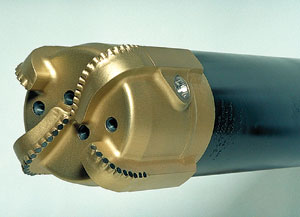New Bit Designs
Hughes Christensen
Casing/liner bit drills tubulars into place without making extra trips
Casing/ liner drilling has been successfully utilized around the world to solve localized drilling challenges. The applications have generally been aimed at minimizing unscheduled events related to wellbore instability while drilling through depleted reservoirs. However, recent technological advances are driving casing/ liner drilling from a niche market into the mainstream drilling environment. Escalating deepwater costs and the need to further reduce onshore drilling expenses in low-cost fields continue to push the technology forward. Improved connections and tubulars, as well as advances in rig technology and pipe handling, have enabled operators to consider drilling with casing/ liner as a viable cost-cutting option on many new wells.
EZ Case solution. To address these issues, Hughes Christensen has introduced new EZ Case (EZC) bit technology, specifically designed for drilling with casing/ liner. EZC features a full, steel alloy head that allows premium PDC cutting elements to be attached to the blades, ensuring a robust cutting structure capable of efficiently drilling new formation, as well as reaming existing hole.
 |
EZ Case bits eliminate extra trips during the casing/ liner drilling process.
|
|
It also features patented technology that utilizes a bearing near the center of the bit face that limits reactive torque. The threshold for bearing engagement is precisely adjusted for each unique application. This provides tool face control similar to roller cone bits and preserves the penetration rate advantage of standard PDC bits. Additionally, the new casing bit features a secondary port that opens during the cementing operation to ensure cement exits the casing at the desired rate and reduces the possibility of plugging.
Field performance. HCC's EZ Case line has proven its worth in several demanding casing/ liner drilling applications. Recently, an 8-1/2-in. EZC304, on a 7-in. liner with a rotating liner hanger, reamed through the swelling Nahr Umr shale in Abu Dhabi, UAE. The bit drilled approximately 3,000 ft to section TD, where it was successfully cemented in place and drilled out. Suitably impressed, the operator picked up a 6-3/4-in. bit and reamed the liner to bottom from vertical to horizontal on the following hole section.
Other significant field performance includes:
- South Texas. An operator loses drilling time while dealing with a lost return issue for 15 days. An 8-1/2-in., 304 bit solves the problem and gets the liner to bottom after several previous runs failed to reach TD.
- Gulf of Mexico. During the first liner drilling in the GOM, a 6-1/2-in. 304 reamed 1,323 ft of hole, then drilled ahead to TD the section at 2,690 ft.
- Central Europe. A 6-in. 306 drilled collapsed sands to TD with a major operator to save the section and successfully reach TD.

|



